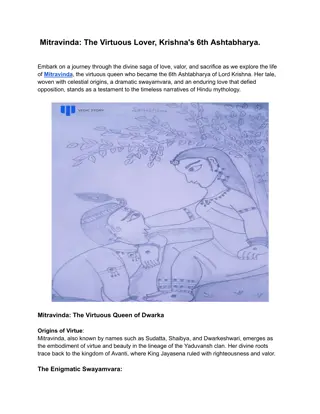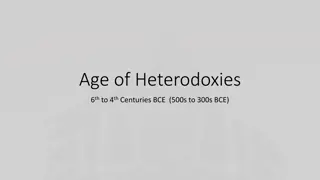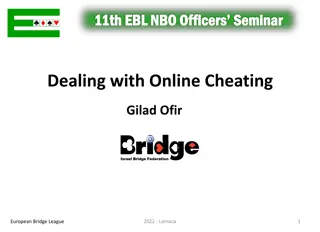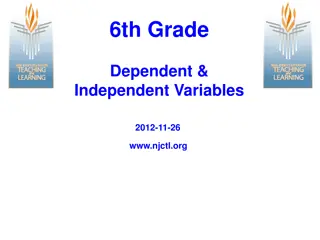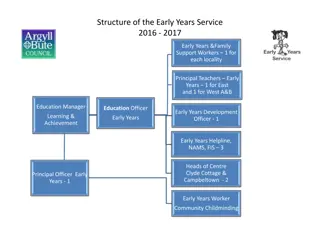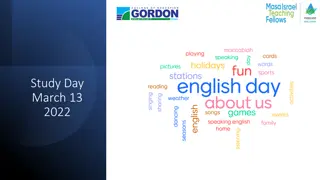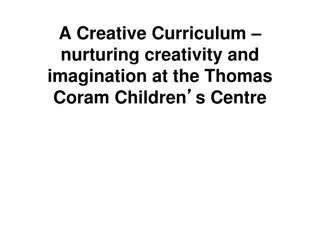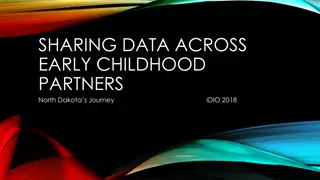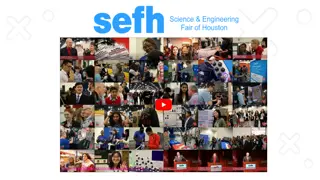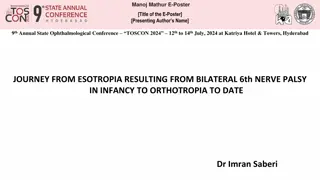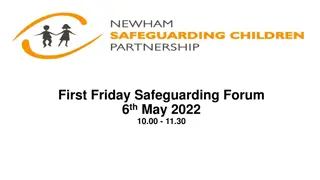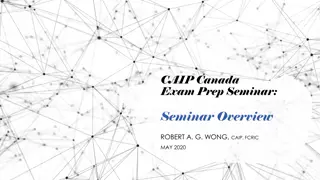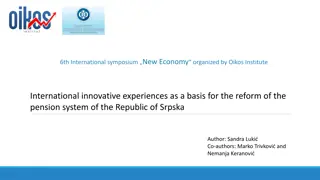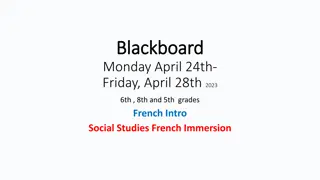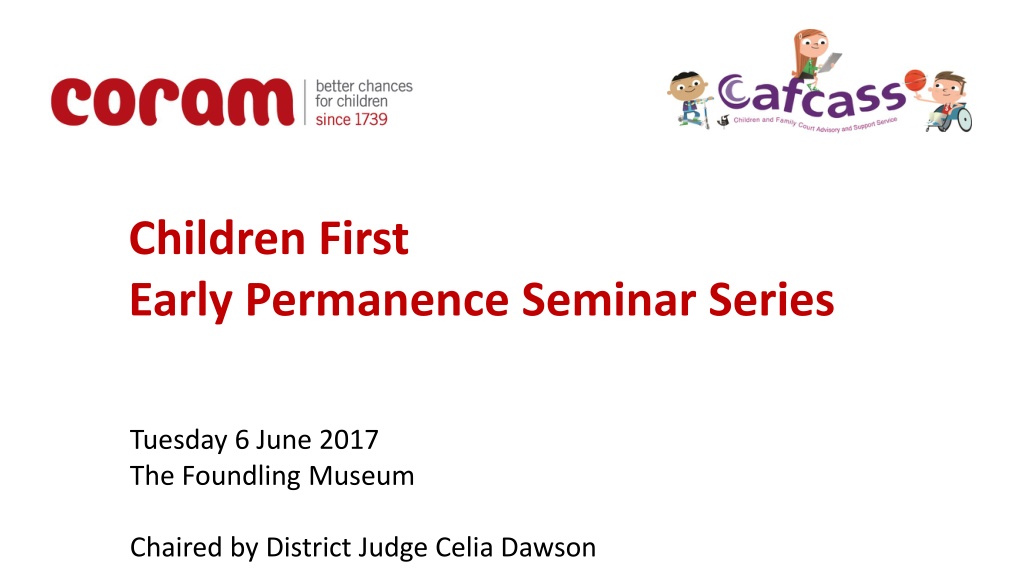
Permanence Seminar Series at The Foundling Museum
"Join the Children First Early Permanence Seminar Series chaired by District Judge Celia Dawson at The Foundling Museum. Discussions on adoption, contact, and a culture of urgency in care cases. Explore early permanence options and more. Don't miss out on this informative event held on June 6, 2017."
Download Presentation

Please find below an Image/Link to download the presentation.
The content on the website is provided AS IS for your information and personal use only. It may not be sold, licensed, or shared on other websites without obtaining consent from the author. If you encounter any issues during the download, it is possible that the publisher has removed the file from their server.
You are allowed to download the files provided on this website for personal or commercial use, subject to the condition that they are used lawfully. All files are the property of their respective owners.
The content on the website is provided AS IS for your information and personal use only. It may not be sold, licensed, or shared on other websites without obtaining consent from the author.
E N D
Presentation Transcript
Children First Early Permanence Seminar Series Tuesday 6 June 2017 The Foundling Museum Chaired by District Judge Celia Dawson
6 6th th June 2017 June 2017 Cafcass and Coram Cafcass and Coram Anthony Douglas CBE, Chief Executive, Cafcass Anthony Douglas CBE, Chief Executive, Cafcass
The adoption triangle over a lifetime The adoption triangle over a lifetime Adoption sets up a false binary opposition between birth parents and adopters a Venn diagram is more realistic.
Contact Contact today today Contact is not a bargaining tool at the court room door, nor a rights- fest e.g., indirect contact is just as complex. Interim contact needs are for children, not parents. Contact should not be polarised to mother v father, but should flow from the child s world, where many children need to stay in touch with siblings and friends as much as parents the child s contact network. Long-term contact needs should recognise the reality for the 21st century child e.g. use of Facetime and Skype.
A culture of urgency A culture of urgency Care cases project managed from the day a child comes into care to the day she or he leaves (using a case tracker) Case plans setting out what needs to be done with any issues about gaps in evidence resolved A timetable that takes into account emotional and psychological processes, as well as court and bureaucratic processes A culture change in teams and individuals - to a culture of urgency Inclusive, problem-solving practice the team around the child in court A concurrent 6 month maximum for all stages of the care and placement process- impossible with serial professionals and multiple placements Extended viability assessments (6-8 weeks) before care proceedings, leading to a single proposition for children subject to care proceedings wherever possible, still within the parameters of the PLO
Early permanence options: the balancing exercise Early permanence options: the balancing exercise EARLY PERMANENCE ANALYSIS, INCLUDING A WELFARE AND PROPORTIONALITY ANALYSIS OF THE PROPOSED PLACEMENT AND CONTACT FRAMEWORK Evidence (including structured professional assessment) Evidence (including structured professional assessment) Evidence (including structured professional assessment) Evidence (including structured professional assessment) Safe reunification Kinship care Permanent (long-term) fostering Adoption Evidence (including structured professional assessment) Special guardianship Evidence (including structured professional assessment) Residential care
Lines of enquiry Lines of enquiry Dad commits to child Concerns expressed by mum about PGM PGM, already a permanent carer for 2 grandchildren, positively assessed for viability Mum s sister assessed for viability Mum engages with social worker on a contract to enter drug rehab MGM commits to safe shared care with child PGF health issues EVIDENCE BASE After social work input, mum supports kinship care placement with PGM Permanence assessment of PGM and PGF concludes positively in 5 weeks Their assessment concludes this will keep both mum and dad positively involved in child s upbringing PGF health issues resolved
The eclectic model of social work in Cafcass The eclectic model of social work in Cafcass
Child Impact analysis in court reporting Child Impact analysis in court reporting
It takes time to get used to the idea It takes time to get used to the idea Hi Anthony, Remember me I was the LAC manager in . when you were there (and also worked in EAT). I know I talked with you about myself and D adopting a child well it is now happening ! We are adopting a little boy, Kemal. Introductions start on 20/02/2017 ! D is still working for Shell he took retirement but later returned to help out I sent him back out to work well it just was not right me working full time whilst he was able to lie in !! Now we will both be taking time off. We were sorting our book cases out and I came across your book about Adoption, which I intend to read again ! Anyway I hope you are keeping well and if you still come to we should try to catch up !! Warm regards, P I worked in from 2002 2004.
Guardians role in foster to adopt placements Clea Barry
London Guardians experiences Cases that went extremely well Cases where there were issues, dilemmas, questions and hesitations Cases where foster to adopt placements were considered but didn t happen
Children were everything went well The carers were exceptional, I couldn t quite believe it was real. The carers were so insightful because of the extra training and support they had received It was fantastic for this baby, she was able to go straight home from the hospital and just stay there without moving They were willing to support direct contact with the parent It was wonderful, she did really well and was a lovely, much loved baby There was something extra about the quality of care they gave
Common factors where everything went well Relinquished or abandoned babies Well planned from early in the pregnancy Some were placed from hospital Second siblings placed with a child who was already adopted and settled Good cultural matches
Families where there were issues, hesitations, dilemmas Complex legal or international issues Difficult trade offs in terms of matching or contact Parents with complex and possibly inheritable health issues New information coming to light during the proceedings Older children, short time scales Placements where the child did not remain with the carers because a family assessment was positive Contact was very difficult and it placed a lot of pressure on the placement
Learning and the guardians role Preparation and information for the adopters about this particular child Timing of the decision and the move The dual edged nature of the investment the carers had in the children Highly emotive cases
Cases where foster to adopt was considered but didnt happen I raised it with the social worker and the IRO but they said there was not a placement available. I supported the LA s proposal for foster to adopt but the judge thought it was premature. The social worker wanted foster to adopt but had not considered placement with the older siblings and this needed careful consideration and support I thought rehabilitation was a real possibility so couldn t support foster to adopt
Learning from the nearly cases Timing of the decision Looking at all the options Guardians role in asking difficult questions and scrutinising the care plan early on Proactive work by IROs and Guardians early on in the case Decisions made very early on can have very long lasting implications

